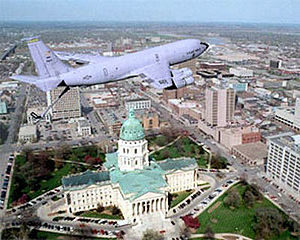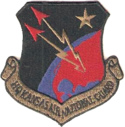Kansas Air National Guard: Difference between revisions
realigned paragraphs and sections |
→History: edited and expanded |
||
| Line 74: | Line 74: | ||
==History== |
==History== |
||
The |
The [[Militia Act of 1903]] established the present National Guard system, units raised by the states but paid for by the Federal Government, liable for immediate state service. If [[Federalization of the National Guard|federalized]] by Presidential order, they fall under the regular military chain of command. On 1 June 1920, the [[Militia Bureau]] issued Circular No.1 on organization of National Guard air units.<ref>ANG Chronology 1908-2007, see also Brief History of the Minnesota Air National Guard and the 133rd Airlift Wing, 1.</ref> |
||
The Kansas Air National Guard origins date to 4 August 1941 with the establishment of the '''127th Observation Squadron'''. It is is oldest unit of the Kansas Air National Guard. It is one of the [[List of United States Army National Guard Observation Squadrons|29 original National Guard Observation Squadrons]] of the [[United States Army National Guard]] formed before [[World War II]]. Initially the squadron had 115 men in its ranks. It was, however, still short of officers since it only had nine officers but was authorized a total of thirty-one. Moved to Sherman Field at Fort Leavenworth, by November of 1941 the squadron had one BE-1, one O-47A, one O-38E and several L-1's. All of the aircraft were single engine observation/liaison planes. The 127th Observation Squadron was ordered into active service on 6 October 1941 as part of the buildup of the Army Air Corps.<ref>[http://www.kansasguardmuseum.org/dispunit.php?id=35 History of the 127th Observation Squadron]</ref> |
|||
[[File:127th Fighter Squadron - F-51D-5-NA Mustang 44-13646.jpg|thumb|left|Kansas Air National Guard F-51D 44-13646, about 1947 at Wichita Municipal Airport.]] |
|||
The modern Kansas ANG received federal recognition on 7 September 1946 as the '''127th Fighter Squadron''' at [[Wichita Municipal Airport]], Wichita. It was equipped with F-51D Mustangs and its mission was the air defense of the state. On 23 February 1957, the '''117th Fighter-Interceptor Squadron''', was federally recognized at [[Hutchinson Air National Guard Base]], Hutchinson, equipped with F-80C Shooting Star jet interceptors. |
The modern Kansas ANG received federal recognition on 7 September 1946 as the '''127th Fighter Squadron''' at [[Wichita Municipal Airport]], Wichita. It was equipped with F-51D Mustangs and its mission was the air defense of the state. On 23 February 1957, the '''117th Fighter-Interceptor Squadron''', was federally recognized at [[Hutchinson Air National Guard Base]], Hutchinson, equipped with F-80C Shooting Star jet interceptors. |
||
Revision as of 13:54, 3 January 2013
| Kansas Air National Guard | |
|---|---|
 KC-135 of the 190th Air Refueling Wing flying over the Kansas State Capitol, Topeka | |
| Active | 17 January 1947 - present |
| Country | |
| Allegiance | |
| Branch | |
| Role | "To meet state and federal mission responsibilities." |
| Part of | Kansas Adjutant General's Department United States National Guard Bureau |
| Garrison/HQ | Kansas Adjutant General's Department, 2722 SW Topeka Blvd Topeka, Kansas, 66611 |
| Commanders | |
| Civilian leadership | President Barack Obama (Commander-in-Chief) Michael B. Donley (Secretary of the Air Force) Governor Sam Brownback (Governor of the State of Kansas) |
| State military leadership | Major General Lee Tafanelli |
| Insignia | |
| Emblem of the Kansas Air National Guard |  |
| Aircraft flown | |
| Tanker | KC-135R Stratotanker |
The Kansas Air National Guard (KS ANG) is the air force militia of the State of Kansas, United States of America. It is, along with the Kansas Army National Guard, an element of the Kansas National Guard.
As state militia units, the units in the Kansas Air National Guard are not in the normal United States Air Force chain of command. They are under the jurisdiction of the Kansas Adjutant General's Department unless they are federalized by order of the President of the United States. The Kansas Air National Guard is headquartered in Topeka, and its commander is currently[update] Brigadier General Bradley S. Link.
Overview
Under the "Total Force" concept, Kansas Air National Guard units are considered to be reserve components of the United States Air Force (USAF). Kansas ANG units are trained and equipped by the Air Force and are operationally gained by a Major Command of the USAF if federalized. In addition, the Kansas Air National Guard forces are assigned to Air Expeditionary Forces and are subject to deployment tasking orders along with their active duty and Air Force Reserve counterparts in their assigned cycle deployment window.
Along with their federal reserve obligations, as state militia units the elements of the Kansas ANG are subject to being activated by order of the Governor to provide protection of life and property, and preserve peace, order and public safety. State missions include disaster relief in times of earthquakes, hurricanes, floods and forest fires, search and rescue, protection of vital public services, and support to civil defense.
Components
The Kansas Air National Guard consists of the following major units:
- Established 15 October 1962; operates: KC-135R Stratotanker
- Stationed at: Forbes Field Air National Guard Base, Topeka; Gained by: Air Mobility Command
- Established 1 October 1962
- Stationed at: McConnell Air Force Base, Wichita; Gained by: Air Force Intelligence, Surveillance and Reconnaissance Agency
History
The Militia Act of 1903 established the present National Guard system, units raised by the states but paid for by the Federal Government, liable for immediate state service. If federalized by Presidential order, they fall under the regular military chain of command. On 1 June 1920, the Militia Bureau issued Circular No.1 on organization of National Guard air units.[1]
The Kansas Air National Guard origins date to 4 August 1941 with the establishment of the 127th Observation Squadron. It is is oldest unit of the Kansas Air National Guard. It is one of the 29 original National Guard Observation Squadrons of the United States Army National Guard formed before World War II. Initially the squadron had 115 men in its ranks. It was, however, still short of officers since it only had nine officers but was authorized a total of thirty-one. Moved to Sherman Field at Fort Leavenworth, by November of 1941 the squadron had one BE-1, one O-47A, one O-38E and several L-1's. All of the aircraft were single engine observation/liaison planes. The 127th Observation Squadron was ordered into active service on 6 October 1941 as part of the buildup of the Army Air Corps.[2]

The modern Kansas ANG received federal recognition on 7 September 1946 as the 127th Fighter Squadron at Wichita Municipal Airport, Wichita. It was equipped with F-51D Mustangs and its mission was the air defense of the state. On 23 February 1957, the 117th Fighter-Interceptor Squadron, was federally recognized at Hutchinson Air National Guard Base, Hutchinson, equipped with F-80C Shooting Star jet interceptors.
On 1 October 1962 the 127th Tactical Fighter Squadron was authorized to expand to a group level, and the 184th Tactical Fighter Group was allotted by the National Guard Bureau, extended federal recognition and activated. That same year, the 117th Tactical Reconnaissance Squadron was expanded on 15 October and the 190th Tactical Reconnaissance Group was federally recognized.
Today the 184th Intelligence Wing (IW) at McConnell Air Force Base provide wartime support in the form of collecting and analyzing intelligence. The 190th Air Refueling Wing (ARW) at Forbes Field AGB, Topeka, provides Global Reach for the United States Air Force through the in-flight refueling of fighters, bombers and other aircraft using the KC-135 Stratotankers.
After the September 11th, 2001 terrorist attacks on the United States, elements of every Air National Guard unit in Kansas has been activated in support of the Global War on Terrorism. Flight crews, aircraft maintenance personnel, communications technicians, air controllers and air security personnel were engaged in Operation Noble Eagle air defense overflights of major United States cities. Also, Kansas ANG units have been deployed overseas as part of Operation Enduring Freedom in Afghanistan and Operation Iraqi Freedom in Iraq as well as other locations as directed.
References
![]() This article incorporates public domain material from the Air Force Historical Research Agency
This article incorporates public domain material from the Air Force Historical Research Agency
- ^ ANG Chronology 1908-2007, see also Brief History of the Minnesota Air National Guard and the 133rd Airlift Wing, 1.
- ^ History of the 127th Observation Squadron
- Gross, Charles J (1996), The Air National Guard and the American Military Tradition, United States Dept. of Defense, ISBN: 0160483026
- Kansas Adjutant General website




